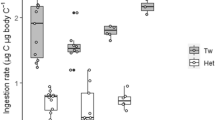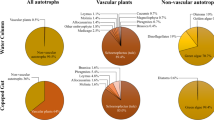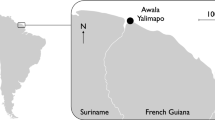Abstract
The pelagic harpacticoid copepod, Macrosetella gracilis (A. Scott), is found in association with colonies of the nitrogen-fixing (diazotrophic), bloomforming cyanobacterium Trichodesmium spp. in tropical and subtropical waters. M. gracilis is one of the few direct grazers of these often toxic cyanobacteria. Experiments investigating NH 4+ regeneration by M. gracilis were conducted in the Caribbean in September 1992 and the Coral Sea, Australia in November 1994. Rates of M. gracilis ingestion of Trichodesmium thiebautii labelled with 15N2 measured in the eastern Caribbean indicated that M. gracilis could consume 33 to 45% of total T. thiebautii colony N d-1 and >100% of new N fixed d-1. We also measured the release of NH 4+ by M. gracilis feeding on T. thiebautii, as well as by non-feeding copepods, using 15N isotope dilution methods. In non-feeding copepods, rates of NH 4+ release increased as numbers of copepods were increased as both copepod numbers and food availability increased. In the presence of T. thiebautii colonies, M. gracilis had an average rate of NH 4+ regeneration of 7.7±1.5 nmol N copepod-1 h-1 (±SE), which was significantly higher than when food was absent (1.9±0.7 nmol N copepod-1 h-1). Rates of M. gracilis excretion were relatively high based on excretion: ingestion ratios, which could be due to having a high-N food source readily available, to “sloppy-feeding” effects, or as a response to toxins in the cyanobacterium. Incubations of M. gracilis with and without T. erythraeum resulted in significant increases in [NH 4+ ] as a function of copepod density only. Ammonium leakage from the cyanobacterium and/or microheterotroph associates was relatively low. M. gracilis, through excretion and possible mechanical breakage of cells while grazing, appears to provide a direct link between atmospherically derived “new” nitrogen and regenerated NH 4+ in the oligotrophic systems where Trichodesmium spp. are abundant.
Similar content being viewed by others
References
Bidigare RR (1983) Nitrogen excretion in marine zooplankton. In: Carpenter EJ, Capone DG (eds) Nitrogen in the marine environment. Academic Press, New York, pp 385–409
Björnberg TKS (1965) Observations on the development and the biology of the Miracidae Dana (Copepoda: Crustacea). Bull mar Sci 15: 512–520
Bollens SM, Frost BW (1989) Predator-induced diel vertical migration in a planktonic copepod. J Plankton Res 11: 1047–1065
Borstad GA, Borstad LE (1977) The Oscillatoria erythraeum (Cyanophyta) community of associates. In: Stewart HB Jr (ed) Cooperative investigations of the Caribbean and adjacent regions — II. FAO Fish Rep 200: 51–57
Capone DG, Carpenter EJ (1982) Nitrogen fixation in the marine environment. Science, NY 217: 1140–1142
Capone DG, Ferrier DM, Carpenter EJ (1994) Amino acid cycling in colonies of the planktonic marine cyanobacterium Trichodesmium thiebautii. Appl envirl Microbiol 60: 3989–3995
Carpenter EJ, Capone DG (1992) Nitrogen fixation in Trichodesmium blooms. In: Carpenter EJ, Capone DG, Rueter JG (eds) Marine pelagic cyanobacteria: Trichodesmium and other diazotrophs. Kluwer Academic Press, Dordrecht, pp 211–217
Carpenter EJ, Price CC (1977) Nitrogen fixation, distribution and production of Oscillatoria (Trichodesmium) spp. in the western Sargasso and Caribbean Seas. Limnol Oceanogr 22: 60–72
Carpenter EJ, Romans K (1991) Major role of the cyanobacterium Trichodesmium in nutrient cycling in the North Atlantic Ocean. Science, NY 254: 1356–1358
Checkley DM (1985) Nitrogen limitation of zooplankton production and its effect on the marine nitrogen cycle. Arch Hydrobiol (Beih Ergebn Limnol) 21: 103–113
Conover RJ, Corner EDS (1968) Respiration and nitrogen excretion by some marine zooplankton in relation to their life cycles. J mar biol Ass UK 48: 49–75
Daniel A, Nagabhushnam AK, Krishnamurthy P (1978) On the occurrence of ‘greenish-yellow’ water phenomenon caused by the swarming of Trichodesmium erythraeum Ehrenberg in the sea off Madras (India) and its effect on the local marine fauna. J Bombay nat Hist Soc 75: 88–95
Devassy VP, Bhattathiri PMA, Qasim SZ (1978) Trichodesmium phenomenon. Indian J mar Sci 7: 168–186
Dugdale RC, Goering JJ (1967) Uptake of new and regenerated forms of nitrogen in primary productivity. Limnol Oceanogr 12: 196–206
Dugdale RC, Menzel DW, Ryther JH (1961) Nitrogen fixation in the Sargasso Sea. Deep-Sea Res 7: 297–299
Endean R, Monks SA, Griffith JK, Llewellyn LE (1993) Apparent relationship between toxins elaborated by the cyanobacterium Trichodesmium erythraeum and those in the flesh of Spanish mackrel, Scomberomorus commerson. Toxicon 31: 1155–1165
Eppley RW, Peterson BJ (1979) Particulate organic matter flux and planktonic new production in the deep ocean. Nature, Lond 282: 677–680
Fiedler R, Proksch G (1975) The determination of nitrogen-15 by emission and mass spectrometry in biochemical analysis: a review. Analytica chim Acta 78: 1–62
Furnas MJ (1992) Pelagic Trichodesmium ( = Oscillatoria) in the Great Barrier Reef region. In: Carpenter EJ, Capone DG, Rueter JG (eds) Marine pelagic cyanobacteria: Trichodesmium and other diazotrophs. Kluwer Academic Press, Dordrecht, pp 265–272
Gardner WS, Paffenhöfer GA (1982) Nitrogen regeneration by the subtropical marine copepod Eucalanus pileatus. J Plankton Res 4: 725–734
Glibert PM, Bronk DA (1994) Release of dissolved organic nitrogen by the marine diazotrophic cyanobacterium Trichodesmium spp. Appl envirl Microbiol 60: 3996–4000
Glibert PM, Garside C, Fuhrman JA, Roman RM (1991) Timedependent coupling of inorganic and organic nitrogen uptake and regeneration in the plume of the Chesapeake Bay estuary and its regulation by large heterotrophs. Limnol Oceanogr 36: 895–909
Glibert PM, Lipschultz F, McCarthy JJ, Altabet MA (1982) Isotope dilution models of uptake and regeneration of ammonium by marine plankton. Limnol Oceanogr 27: 639–650
Glibert PM, Miller CA, Garside C, Roman MR, McManus GB (1992) Ammonium regeneration and grazing: interdependent processes in size-fractionated 15NH ++ experiments. Mar Ecol Prog Ser 82: 65–74
Hahn ST, Capra MF (1993) The cyanobacterium Oscillatoria erythraea — a potential source of toxin in the ciguatera food-chain. Fd Addit Contam 9: 351–355
Harris RP (1973) Feeding, growth, reproduction and nitrogen utilization by the harpacticoid copepod Tigriopus brevicornis. J mar biol Ass UK 53: 785–800
Harwood JL, Pettitt TP, Jones AL (1988) Lipid metabolism. In: Rogers LJ, Gallon JR (eds) Biochemistry of the algae and cyanobacteria. Proceedings of the Phytochemical Society of Europe. Clarendon Press, Oxford, pp 49–67
Hawser SP, Codd GA, Capone DG, Carpenter EJ (1991) A neurotoxic factor associated with bloom-forming cyanobacterium Trichodesmium. Toxicon 3: 277–278
Hawser SP, O'Neil JM, Roman MR, Codd GA (1992) Toxicity of blooms of the cyanobacterium Trichodesmium to zooplankton. J appl Phycol 4: 79–86
Ikeda T (1974) Nutritional ecology of marine zooplankton. Mem Fac Fish Hokkaido Univ 22: 1–97
Ikeda T (1985) Metabolic rates of epipelagic marine zooplankton as a function of body mass and temperature. Mar Biol 85: 1–11
Ikeda T, Hing Fay E, Hutchinson SA, Boto GM (1982) Ammonia and inorganic phosphate excretion by zooplankton from inshore waters of the Great Barrier Reef, Queensland. I. Relationship between excretion rates and body size. Aust J mar Freshwat Res 33: 55–70
Kana TM (1990) Light-dependent oxygen cycling measured by an oxygen-18 isotope dilution technique. Mar Ecol Prog Ser 64: 293–300
Karl DM, Letelier R, Hebel DF, Bird DF, Winn CD (1992) Trichodesmium blooms and new nitrogen in the North Pacific Gyre. In: Carpenter EJ, Capone DG, Rueter JG (eds) Marine pelagic cyanobacteria: Trichodesmium and other diazotrophs. Kluwer Academic Press, Dordrecht, pp 219–238
Lehman JT (1980) Release and cycling of nutrients between planktonic algae and herbivores. Limnol Oceanogr 25: 620–632
Mague TH, Mague FC, Holm-Hansen O (1977) Physiology and chemical composition of nitrogen fixing phytoplankton in the central North Pacific. Mar Biol 41: 213–227
McCarthy JJ, Carpenter EJ (1979) Oscillatoria (Trichodesmium) thiebautii (cyanophyta) in the central North Atlantic. J Phycol 15: 75–82
Miller CA (1992) Effects of food quality and quantity on nitrogen excretion by the copepod Acartia tonsa. PhD thesis, University of Maryland, College Park, Maryland
Nagabhushanam AK (1967) On an unusually dense phytoplankton bloom around Minicoy Island (Arabian Sea) and its effect on the local tuna fisheries. Curr Sci 22: 611–612
O'Neil JM, Roman MR (1992) Grazers and associated organisms of Trichodesmium. In: Carpenter EJ, Capone DG, Rueter JG (eds) Marine pelagic cyanobacteria: Trichodesmium and other diazotrophs. Kluwer Academic Press, Dordrecht, pp 61–73
O'Neil JM, Roman RM (1994) Ingestion of the cyanobacterium Trichodesmium spp. by the pelagic harpacticoid copepods Macrosetella, Miracia and Oculosetella. Hydrobiologia 293: 235–240
Porter KG, Orcutt JD Jr (1980) Nutritional adequacy, manageability, and toxicity as factors that determine food quality of green and blue-green algae for Daphnia. In: Kerfoot WC (ed) Evolution and ecology of zooplankton communities. University Press of New England, Hanover, New Hampshire, pp 268–281
Prufert-Bebout L, Paerl HW, Lassen C (1993) Growth, nitrogen fixation, and spectral attentuation in cultivated Trichodesmium species. Appl envirl Microbiol 59: 1367–1375
Roman MR (1978) Ingestion of the blue-green algae Trichodesmium by the harpacticoid copepod, Macrosetella gracilis. Limnol Oceanogr 23: 1245–1255
Roman MR (1983) Nitrogenous nutrition of marine invertebrates. In: Carpenter EJ, Capone DG (eds) Nitrogen in the marine environment. Academic Press, New York, pp 347–383
Ryther JH, Dunstan WM (1971) Nitrogen, phosphorous, and eutrophication in the marine environment. Science, NY 171: 1008–1013
Sellner KG (1992) Trophodynamics of marine cyanobacteria blooms. In: Carpenter EJ, Capone DG, Rueter JG (eds) Marine pelagic cyanobacteria: Trichodesmium and other diazotrophs. Kluwer Academic Press, Dordrecht, pp 75–94
Sokal RR, Rohlf FJ (1981) Biometry. WH Freeman Co, New York
Soloranzo L (1969) Determination of ammonia in natural waters by the phenolhypochlorite method. Limnol Oceanogr 14: 799–801
Thorensen SS, Dortch Q, Ahmed SI (1982) Comparison of methods for extracting intracellular pools of inorganic nitrogen from marine phytoplankton. J Plankton Res 4: 695–703
Verity PG (1985) Ammonia excretion rates of oceanic copepods and implications for estimates of primary production in the Sargasso Sea. Biol Oceanogr (NY) 3: 249–283
Welschmeyer NA, Copping AE, Vernet M, Lorenzen CJ (1984) Diel fluctuation in zooplankton grazing rate as determined from downward flux of phaeopigments. Mar Biol 83: 263–270
White AW (1981) Marine zooplankton can accumulate and retain dinoflagellate toxins and cause fish kills. Limnol Oceanogr 26: 103–109
Wood BJB (1974) Fatty acids and saponifable lipids. In: Stewart WDP (ed) Algal physiology and biochemistry. Blackwell Press, Oxford, pp 236–265
Author information
Authors and Affiliations
Additional information
Communicated by J.P. Grassle, New Brunswick
Rights and permissions
About this article
Cite this article
O'Neil, J.M., Metzler, P.M. & Glibert, P.M. Ingestion of 15N2-labelled Trichodesmium spp. and ammonium regeneration by the harpacticoid copepod Macrosetella gracilis . Marine Biology 125, 89–96 (1996). https://doi.org/10.1007/BF00350763
Received:
Accepted:
Issue Date:
DOI: https://doi.org/10.1007/BF00350763




